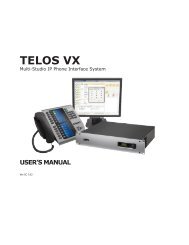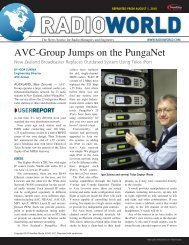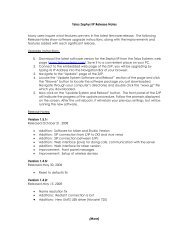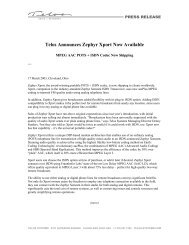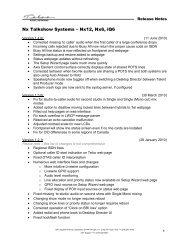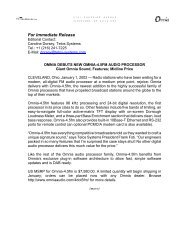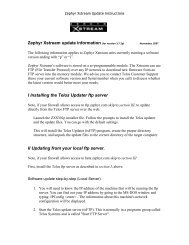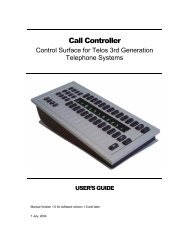NOW! 12-13 - Telos
NOW! 12-13 - Telos
NOW! 12-13 - Telos
You also want an ePaper? Increase the reach of your titles
YUMPU automatically turns print PDFs into web optimized ePapers that Google loves.
OMNIA | FM-STEREO TRANSMISSION | TECHNOLOGY ARTICLE<br />
56<br />
SINGLE SIDEBAND SUPPRESSED CARRIER (SSBSC)<br />
Figure-<strong>13</strong>, Peak Level, 15kHz, L-Ch<br />
Notice the reduction in utilized RF spectrum. The signal shown<br />
in Figure–<strong>12</strong> will pass through narrow cavities, combiners, and<br />
mal-adjusted antennas with better stereo performance than the<br />
broader signal shown in Figure–10.<br />
Additionally, there are less sideband pairs of the carrier signal.<br />
Less sideband pairs equates to less signals, which can be inter-<br />
fered with during instances of multipath.<br />
In the United States, FM channel spacing is maintained at 200kHz.<br />
This is a bit of a luxury compared to the rest of the world where<br />
channel spacing is usually 100kHz. Consider the probability of<br />
less channel-to-channel interference when SSBSC transmission<br />
could be used. This would appear to be an improved alternative<br />
to the ITU BS-4<strong>12</strong> MPX power regulation, which is now in force in<br />
some European countries.<br />
Another mentioned beneit SSB brings to the transmission<br />
method is added spectral protection to RBDS, SCA, and HD Radio<br />
services as observed in Figure–14. Single channel only pink noise<br />
is used to generate the baseband signal with SSBSC modulation.<br />
Notice the extremely wide guard band that exists between 38kHz<br />
and where the irst SCA carrier would appear at 57kHz. The reduc-<br />
tion in cross-talk to ancillary services is exceptional!<br />
Figure-14, Reduction in Cross-Talk to Ancillary Services.<br />
SSBSC AND MODULATION PEAK CONTROL<br />
Implementing SSB can be accomplished using numerous tech-<br />
niques. The most common method is through use of the Hilbert<br />
function, where a 90 degree broadband phase shift is used to<br />
cancel the undesired sideband. It can also be achieved using<br />
a Weaver modulator, or a low pass ilter set to critically limit<br />
the desired passband, and the undesired sideband is removed<br />
through iltering. All of these methods provide satisfactory<br />
SSB operation, but there is a critical element that must be con-<br />
sidered…peak control of the overall MPX signal. In each of the<br />
afore-mentioned SSB methods, there will be alteration to the<br />
phase relationship of the sideband signal. This alone will gener-<br />
ate overshoot to MPX encoded signal [3]. It is paramount that<br />
SSB modulation must not add any overshoot to the signal, and<br />
it must not add any unwanted non-linear components, in the<br />
form of audible overshoot peak limited harmonic content, i.e.<br />
clipping by-products. The sonic performance of the SSBSC mod-<br />
ulator must perform sonically, exactly the same as the DSBSC<br />
counterpart. Switching from DSBSC mode to SSBSC should not<br />
change the resulting sound in stereo separation, audio quality,<br />
and peak control.<br />
Theory indicates that a 90 degree phase network, in the form of<br />
a Hilbert ilter will cause overshoot to a square wave. What’s in-<br />
teresting is by adding a second Hilbert function, the overshoot<br />
is removed, and the square wave is recovered. Use of the double<br />
Hilbert function has been referred to as the “Dilbert” function [4].<br />
An example of this is provided in Figure-15.<br />
Figure-15, Hilbert Affect on Square Waves<br />
Normalized Amplitude<br />
2<br />
1<br />
0<br />
-1<br />
-2<br />
-3<br />
0<br />
0.001<br />
0.002 0.003 0.004<br />
Time (Seconds)<br />
0.005 0.006 0.007<br />
400 Hz Band Limited Squarewave Hilbert Transform of Squarewave Dilbert Transform of Squarewave<br />
Just as an audio processor is known to employ non-audible<br />
methods to eliminate peak overshoots in the required 15kHz<br />
low pass ilters, there are non-audible algorithms employed<br />
in the SSBSC generator which insures that any overshoots are<br />
eliminated, and done so without any sonic change or affect to<br />
audio quality. Figure-16 is a screen capture from a digital oscil-<br />
loscope that was measuring real world MPX signal at the output<br />
of an audio processor. Figure-17 is the spectral reproduction of<br />
the same signal. Note exceptional peak control along with the<br />
well maintained spectrum around the 19kHz pilot, and the sharp<br />
drop off after 38kHz.



